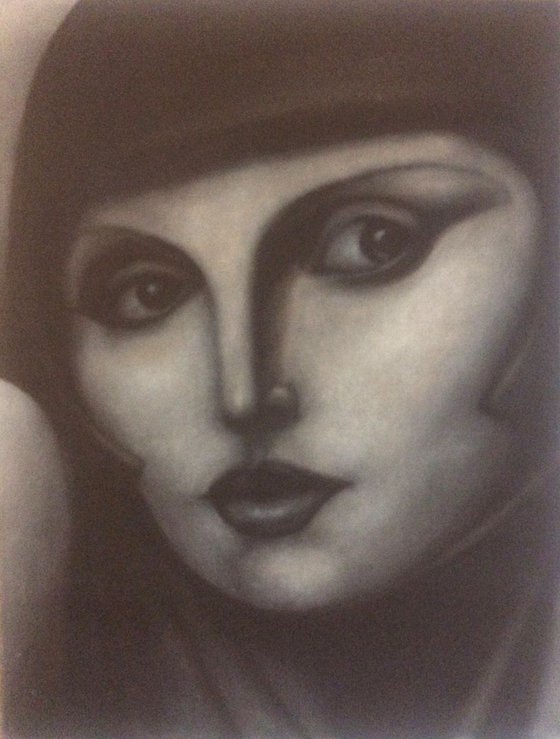- By medium
- By subject
- By budget
- Sales
- Gift cards
- Discover all art
- Artists
- Editors’ picks
- Ideas
Original artwork description:
Sadie:
This lady too, as her gaze suggests has already seen many of the trials and tribulations of the world, she may apparently have suffered and so remains strongly disenchanted, but firm. With her charming nose and her large entangled eyes she is definitely an expression of a great nevertheless.
From the Collection:
Dark Deco Celebrities 2016
A Suite of Impressive Ladies
With a sophisticated painting technique Marcus Sprigens is successful in giving his elegant female faces a translucent skin which reminds us of the attractive transparency of the most prominent porcelain known as bone china or exclusive Japanese lacquered surfaces. His portraits are stylistically inspired by the famous pictures of Tamara de Lempicka who was a true celebrity and one of the most renowned female artists of her time. To date she is considered as a leading icon of Art Deco paintings. Her portraits combine rational coolness and sensual presence in a remembrance to Renaissance art, especially to that of Sandro Botticelli. Lempicka was one of the most sought after artists of the 1920s and 1930s. Only about 150 paintings by her are known from that time. The subtitle of a monography of her work describes her artificial mood in a precise way: “A life dedicated to décor and decadence”.
Marcus Sprigens has focused the spirit of those paintings in his, based purely on the physiognomy. He completely renounces the chic interior design and fashion accessories which characterize Lempicka's pictures. On the contrary he concentrates entirely on the internal proportions of the faces. The forms of the chins, mouths and noses, eyes and eye brows define the expression of the faces which are always shown in a three-quarter profile. They are defined by eyes with perfect make up and kissing or pouting lips. So these ladies are icons of a perfect style of classical cosmetic strategies which give homage to the ideal of timeless beauty. Nefertiti meets burlesque dancer Dita von Teese with a ladylike appearance and nostalgic visual references to the legendary divas of the Hollywood cinema. The world as Will and Representation.
This suite of paintings are titled Dark Deco, worked in dark and light tones. The allusion to the term Art Deco shows inspiration from this stylistic era with an added fatalistic development of its essentials. In fact, the six ladies by Sprigens are very urban and elegant, but they seem to also know a dangerous existence from the perspective of the night: bars, lonely nightcaps, one night stands, hire and fire situations. On the other hand they also radiate consolation and defiance, in the now. So the artist succeeds with this handful of portraits in creating a psychograph of moods, injuries, obsessions and hopes, combined with feminine elegance and refinement. A condition humaine en miniature.
The artist uses a special technique for this collection of paintings. In order to shorten the drying time process of the oil paint, he combines oil and acrylic painting. Firstly a dark acrylic background on the canvas is applied to create a subtle texture that dries rapidly. Then follows an oil paint layer which takes that texture. This technique is in a way similar to the old black and white Grisaille technique. The difference with this style is that Sprigens starts with a dark tone as opposed to a mid-tone and then using white oil paint he creates the forms and contours. The shadows remain in the image from the original underpainting. It is possible to reapply the acrylic colour onto dry oil paint to avoid any imperfections. Then again oil colours may be re-applied over the top of the dark underlaying colour. This procedure saves much time in comparison to glazing the painting with linseed oil. Finally transparent glazes and subtle colourings in acrylic paint occur over the oil. This technique was probably also used with just oils by Michelangelo da Caravaggio, the most important master of the early Baroque chiaroscuro painting. Sprigens calls his technique lumen obscura, referring to the process of bringing light into the dark. So one may say, that this is really a new, fresh kind of enlightening.
Text by Prof. Dr. Volker Fischer, Master Curator, Art Historian and Critic, Former Senior Curator of the Museum of Arts and Craft (MAK) Frankfurt, Former Vice Director of the German Museum of Architecture (DAM) Frankfurt, Honorary Professor of the Academy of Art and Design, Offenbach am Main / Frankfurt.
Materials used:
Oils, Acrylics
Tags:
#grisaillle #portrait #black and white #chiaroscuroSadie (2016) Oil painting
by Marcus Sprigens
1 Artist Reviews
£250 Sold
- Oil painting on Canvas
- One of a kind artwork
- Size: 30 x 40 x 2cm (unframed) / 30 x 40cm (actual image size)
- Signed on the back
- Style: Impressionistic
- Subject: People and portraits
Do you like this artwork?
This artwork has sold, but the artist is accepting commission requests. Commissioning an artwork is easy and you get a perfectly personalised piece.
Loading
Original artwork description
Sadie:
This lady too, as her gaze suggests has already seen many of the trials and tribulations of the world, she may apparently have suffered and so remains strongly disenchanted, but firm. With her charming nose and her large entangled eyes she is definitely an expression of a great nevertheless.
From the Collection:
Dark Deco Celebrities 2016
A Suite of Impressive Ladies
With a sophisticated painting technique Marcus Sprigens is successful in giving his elegant female faces a translucent skin which reminds us of the attractive transparency of the most prominent porcelain known as bone china or exclusive Japanese lacquered surfaces. His portraits are stylistically inspired by the famous pictures of Tamara de Lempicka who was a true celebrity and one of the most renowned female artists of her time. To date she is considered as a leading icon of Art Deco paintings. Her portraits combine rational coolness and sensual presence in a remembrance to Renaissance art, especially to that of Sandro Botticelli. Lempicka was one of the most sought after artists of the 1920s and 1930s. Only about 150 paintings by her are known from that time. The subtitle of a monography of her work describes her artificial mood in a precise way: “A life dedicated to décor and decadence”.
Marcus Sprigens has focused the spirit of those paintings in his, based purely on the physiognomy. He completely renounces the chic interior design and fashion accessories which characterize Lempicka's pictures. On the contrary he concentrates entirely on the internal proportions of the faces. The forms of the chins, mouths and noses, eyes and eye brows define the expression of the faces which are always shown in a three-quarter profile. They are defined by eyes with perfect make up and kissing or pouting lips. So these ladies are icons of a perfect style of classical cosmetic strategies which give homage to the ideal of timeless beauty. Nefertiti meets burlesque dancer Dita von Teese with a ladylike appearance and nostalgic visual references to the legendary divas of the Hollywood cinema. The world as Will and Representation.
This suite of paintings are titled Dark Deco, worked in dark and light tones. The allusion to the term Art Deco shows inspiration from this stylistic era with an added fatalistic development of its essentials. In fact, the six ladies by Sprigens are very urban and elegant, but they seem to also know a dangerous existence from the perspective of the night: bars, lonely nightcaps, one night stands, hire and fire situations. On the other hand they also radiate consolation and defiance, in the now. So the artist succeeds with this handful of portraits in creating a psychograph of moods, injuries, obsessions and hopes, combined with feminine elegance and refinement. A condition humaine en miniature.
The artist uses a special technique for this collection of paintings. In order to shorten the drying time process of the oil paint, he combines oil and acrylic painting. Firstly a dark acrylic background on the canvas is applied to create a subtle texture that dries rapidly. Then follows an oil paint layer which takes that texture. This technique is in a way similar to the old black and white Grisaille technique. The difference with this style is that Sprigens starts with a dark tone as opposed to a mid-tone and then using white oil paint he creates the forms and contours. The shadows remain in the image from the original underpainting. It is possible to reapply the acrylic colour onto dry oil paint to avoid any imperfections. Then again oil colours may be re-applied over the top of the dark underlaying colour. This procedure saves much time in comparison to glazing the painting with linseed oil. Finally transparent glazes and subtle colourings in acrylic paint occur over the oil. This technique was probably also used with just oils by Michelangelo da Caravaggio, the most important master of the early Baroque chiaroscuro painting. Sprigens calls his technique lumen obscura, referring to the process of bringing light into the dark. So one may say, that this is really a new, fresh kind of enlightening.
Text by Prof. Dr. Volker Fischer, Master Curator, Art Historian and Critic, Former Senior Curator of the Museum of Arts and Craft (MAK) Frankfurt, Former Vice Director of the German Museum of Architecture (DAM) Frankfurt, Honorary Professor of the Academy of Art and Design, Offenbach am Main / Frankfurt.
Materials used:
Oils, Acrylics
Tags:
#grisaillle #portrait #black and white #chiaroscuro14 day money back guaranteeLearn more

